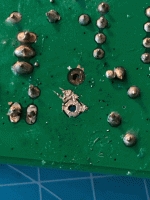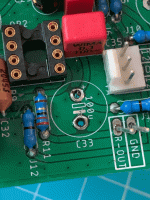IMHO 4495 is worth than 90/93 and especially 4497/99.Maybe your AK4495 came from a sewer.
it is all about the implementation. Just mentioning the dac chip does not tell anything.
500%!
Yes, the numbering is a bit misleading as even spec-wise AK4495 is clearly the worst of the lot.IMHO 4495 is worth than 90/93 and especially 4497/99.
I spoke with one commercial DAC engineer and he has the same experience with AK. This guy can develop digital filters and custom DACs on FPGA and he has much much more experience with delta-sigma than I do 🙂Maybe your AK4495 came from a sewer.
Last edited:
Do you have schematic or closer image?BTW regarding Marantz MMM: what kind of DAC is in their SA-10 with 4x 74AHCT574?
I don't think you're the only one. I noticed this a long time ago. That's why I did DDDAC with PCM1794, even if it is not R2R.Many people who switched to the R-2R without a digital filter felt a kind of relief. I'm glad I'm not alone, otherwise I would think I have a mental disorder 🤣

Last edited:
BTW regarding Marantz MMM: what kind of DAC is in their SA-10 with 4x 74AHCT574?
- Innovative Marantz Musical Mastering “MMM-Stream” up-sampling to DSD and filtering
- Custom-designed 1-bit direct “MMM–Conversion” from DSD to analogue
The SA-10 has no DAC at all: it converts everything to a fast stream and filters this through a low pass. All information about the circuit and the logic ICs I could not find any more...
Extraordinarry bass and mid bass was with dual mono WM8740 in NOS mode, I2S input, full recklocking every line 2xFF cascode, digitl bus isolation, Balanced configurantion, JFET 2x Buffers, some HF analog filter and transformar out. This is No1 simple dac to compare every other with. (Do not use single chip for booth channels - cant comprae to mono mode... like it is another chip playing)
But without classic OP amps style IV at the end. Totally opposite on that You are doing in this topic with ultrahigh persistence.
Like the task is - saving the PCB space / NOT better sound...
I remember decades before when override OP end in one TDA1541A CD player with Diamond IV from 6 transistors only, and without matching, Just that OS with some SAA7xxx was present still - it was so better that few of us listened, simply could not believed...
That is very hard for me to believe honey words about the these dacs with OP end 🙂 sorry
.
Other simply big sounding DAC was early ES9008, also in NOS mode, full recklocking every line 2xFF cascode, digitl bus isolation. I did 2 dac chips with LL+RR I2S recomposing. Ouput stage was with OP amps, only this time), But not as in usual way sort of Riv/OP amp same time. Differentioal mode also. Line transformer end. Impressive bass. Way better than othe ES chips that came latter. with 0db digital att. (These others newer probaly is very good BUT i Think that is the must to set control registers to -6db. I didnt done that with these new models, so I could not claim) ES9008 is simply - the star 🙂
.
Other big moment was even earlier - 16 TDA1543, same full recklocking, NOS very simple Riv and just one Cout... WOW. Musical up to the stars... 1 x same dac or even 8 x just could not be compared... 🙂
.
Next PMD100 fascination. Stand alone mode 8x OS. First song first questions: how this PMD100 can bihgs OS so much better than any other same purpose part? How it is posibile that the diference so huge compared to PHI SAA? How it is posibile at once. that does not matter is the OS or NOS mode? And when HDCD format was in action al these Q was so bigger. 🙂 BTW HDCD has -6db digiral attenuation from original...
.
For the last sparc: before maybe 10 years I made first TDA1540 based dac. NOS mode. Riv JFET gain. JFET buffer end. And I was pretty amazed with the sound of 14bits. Latter I rationalized oppinion and be catched with Time simultaneous format. I think that is the main catch. And of course BJT architecture inside this beautiful dac - not MOSFET. Big bass, bigg everything. I even remember first song that I played on dac "telegraf road"... Only this dac chip can convert digital square whave signal of 20KHz to analog complement, straight angles and undistorted shape. Every other chip strats from 2KHz to ruin the angles of squared analog shape gravitating to sort of sinus. 🙂. That is whay we cant see square w conversion results and measurements on DACs in the datasheets.
And it is the dac that almost continualy plaing when change SR on computer software player. Without any click, pause or else.
.
Only one dac was "faster" to changes of SR was LADDER R-2R diskrete dac...
Latter on that caegory 🙂
.
(I didnt use Tube end at the dacs i built for myself just because i have all from dac out with tubes. Dint saw the point at that time, to employ another tube stage with huge HV pover supply and all that 2X for dual mono...)
But without classic OP amps style IV at the end. Totally opposite on that You are doing in this topic with ultrahigh persistence.
Like the task is - saving the PCB space / NOT better sound...
I remember decades before when override OP end in one TDA1541A CD player with Diamond IV from 6 transistors only, and without matching, Just that OS with some SAA7xxx was present still - it was so better that few of us listened, simply could not believed...
That is very hard for me to believe honey words about the these dacs with OP end 🙂 sorry
.
Other simply big sounding DAC was early ES9008, also in NOS mode, full recklocking every line 2xFF cascode, digitl bus isolation. I did 2 dac chips with LL+RR I2S recomposing. Ouput stage was with OP amps, only this time), But not as in usual way sort of Riv/OP amp same time. Differentioal mode also. Line transformer end. Impressive bass. Way better than othe ES chips that came latter. with 0db digital att. (These others newer probaly is very good BUT i Think that is the must to set control registers to -6db. I didnt done that with these new models, so I could not claim) ES9008 is simply - the star 🙂
.
Other big moment was even earlier - 16 TDA1543, same full recklocking, NOS very simple Riv and just one Cout... WOW. Musical up to the stars... 1 x same dac or even 8 x just could not be compared... 🙂
.
Next PMD100 fascination. Stand alone mode 8x OS. First song first questions: how this PMD100 can bihgs OS so much better than any other same purpose part? How it is posibile that the diference so huge compared to PHI SAA? How it is posibile at once. that does not matter is the OS or NOS mode? And when HDCD format was in action al these Q was so bigger. 🙂 BTW HDCD has -6db digiral attenuation from original...
.
For the last sparc: before maybe 10 years I made first TDA1540 based dac. NOS mode. Riv JFET gain. JFET buffer end. And I was pretty amazed with the sound of 14bits. Latter I rationalized oppinion and be catched with Time simultaneous format. I think that is the main catch. And of course BJT architecture inside this beautiful dac - not MOSFET. Big bass, bigg everything. I even remember first song that I played on dac "telegraf road"... Only this dac chip can convert digital square whave signal of 20KHz to analog complement, straight angles and undistorted shape. Every other chip strats from 2KHz to ruin the angles of squared analog shape gravitating to sort of sinus. 🙂. That is whay we cant see square w conversion results and measurements on DACs in the datasheets.
And it is the dac that almost continualy plaing when change SR on computer software player. Without any click, pause or else.
.
Only one dac was "faster" to changes of SR was LADDER R-2R diskrete dac...
Latter on that caegory 🙂
.
(I didnt use Tube end at the dacs i built for myself just because i have all from dac out with tubes. Dint saw the point at that time, to employ another tube stage with huge HV pover supply and all that 2X for dual mono...)
Last edited:
@Zoran That bass from TDA1540 during a quick test convinced me to create this DAC, it's something very special 👍
YesGreat bass even though two bits are missing?😱
2 Last Siginificant Bits ... 🙁
Get a new cap, push the positive leads through, bend it towards jumper 13, solder the cap lead to the pad of jumper 13.
That bass is something different, I have not heard before and I am glad that Zoran experienced the sameGreat bass even though two bits are missing?😱
 ... soon the whole DIY community will have the opportunity to try it
... soon the whole DIY community will have the opportunity to try it 
Wait Iancana.., he is reading this thread, lol.
How to makee monney with the work of others....
https://www.audiophonics.fr/fr/sing...tage-iv-symetrique-zero-feedback-p-17013.html.... ahaha I ask him to clone my dog ! Uh, no cause if it is like this pcb with outputs at 90% I could just use my new dog just in the corner of a box... too bad !
Vunce, you get copied by him, what Rogic should think of that ? Maybe he authorized Ian, who knows ?
How to makee monney with the work of others....
https://www.audiophonics.fr/fr/sing...tage-iv-symetrique-zero-feedback-p-17013.html.... ahaha I ask him to clone my dog ! Uh, no cause if it is like this pcb with outputs at 90% I could just use my new dog just in the corner of a box... too bad !
Vunce, you get copied by him, what Rogic should think of that ? Maybe he authorized Ian, who knows ?
- Home
- Source & Line
- Digital Line Level
- DAC AD1862: Almost THT, I2S input, NOS, R-2R

